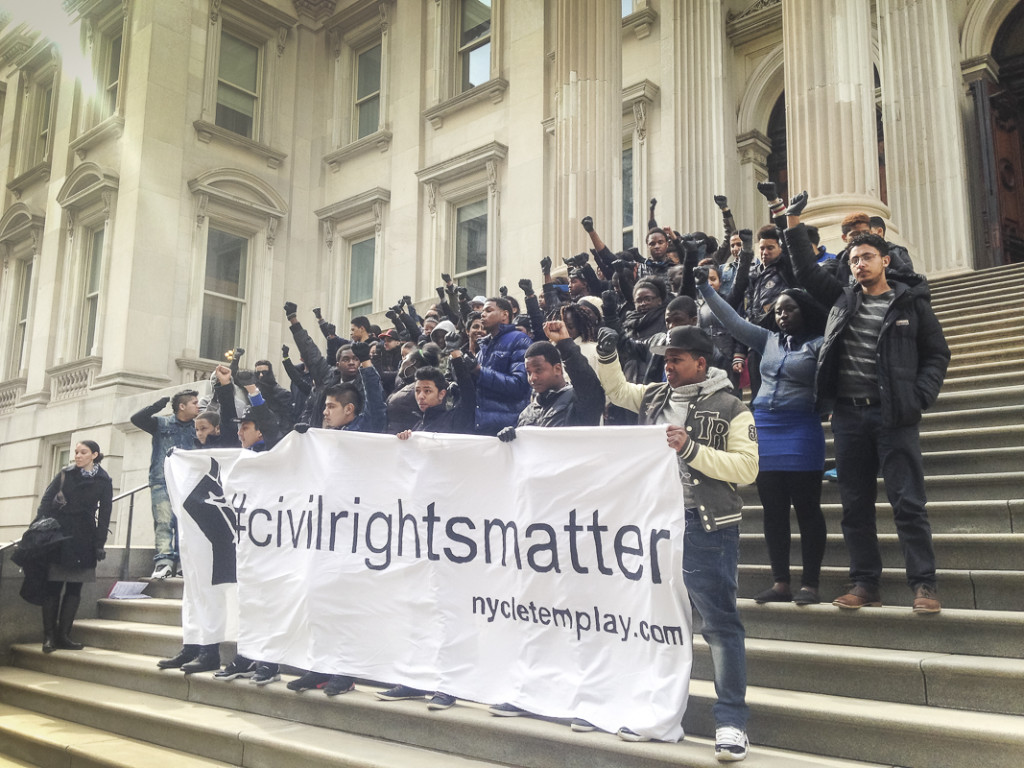
Dozens of students from the International Community High School protest in front of the Tweed Courthouse on March 25th. The banner reads “Civil Rights Matter.”
Like many high school students in New York City, Fatou Boye, a senior at the International Community High School in the Bronx, likes to stay busy outside the classroom. But she can’t participate in her favorite sport, soccer — an injustice a growing number of students and staff say reflects segregated sports opportunities within a segregated school system.
Data gathered from the websites of the Department of Education and the Public Schools Athletic League — the established system of providing sports programs to public schools — indicates that black and Hispanic students are twice as likely as their white and Asian classmates to attend high schools with very few, if any, sports. Staten Island’s Tottenville High School or Brooklyn Technical High school, where most of the students are white, enjoy over 40 sports teams each year. But 110 of the city’s schools have between zero and six teams each year. And the student population at those schools just happens to be 90 percent students of color.
In 2013, David Garcia-Rosen, former dean at International, was one of the first to sound the alarm. Garcia-Rosen released a report claiming that black and Latino students have significantly less access to sports. The former dean went on to file a federal civil rights complaint against the Department of Education. Garcia-Rosen and his students have been fighting to bring sports to International for well over a year.
There are several reasons for the disparate access: School reformers have pushed over the last decade to dismantle large, failing schools in poorer neighborhoods, such as the South Bronx, which disproportionately enroll minority students. The small schools have less access to facilities, and less budgetary flexibility, than large high schools. Also, students older than 18 are not eligible to participate in official sports, but students from low-income backgrounds often take longer than normal to graduate. Students in poorer communities also often have less empowered parents, and sometimes teachers, to lobby for their interests.
The International Community High School serves recent immigrants who have been living in the U.S. for four years or less. Over 90 percent of students are English language learners: Many arrive with minimal proficiency in their own language, according to school staff. For the majority of students — about 60 percent — it takes longer than four years to graduate. In this school, having sports is essential, said Maria Damato, college counselor at the International. “Sports affect our graduation rates, dropout rates, gang activity,” Damato said. “We had baseball players return from dropping out, just to join our baseball team.”
On March 25, dozens of students from International spoke out during a public hearing on education at City Hall. They demanded equal access to high school sports for black and Latino students. With banners and chants — “Civil Rights Matter” — they then moved to Chambers Street to continue the protest on the steps of Tweed Courthouse. Later in the hearing, Chancellor Carmen Farina acknowledged the need for more sports in high schools. But she said many of the small schools share their building with several other schools, creating limited facilities.
The Education Department claims that 90 percent of students attending a public high school in New York City have access to Public Schools Athletic League sports. But with even one sport available in a school, students are counted as having fair access.
Part of the problem is the league student eligibility requirements, which skeptics say discriminate against low-income, overage students. In order for a student to participate in the league’s athletic competitions, he has to have good attendance, strong grades and be below 19 years of age.
Hassanatou Samake, who arrived in New York five years ago from Mali, is an International student and leader at NYCLetEmPlay. She did not speak any English when she first arrived, but the school soccer team helped change that. “I played soccer in Mali, too. Mali is not developed but our schools still have sport teams,” she said. Samake is 20, and therefore not allowed to participate in official league competitions. The advocacy group that Samake and Boye are part of put forward five demands to the Department of Education:
- Provide every high school with six teams of their choice
- Fund and facilitate a community-based high school sports league for students who go to school without the sport they want to play.
- Equitably share all NYC DOE owned fields and courts.
- Equitably share all public park permits issued to the NYC DOE.
- Return our College Counselor Ms. Damato and our Dean Mr. David to our school.
The fifth demand was added on March 26. A day after the students protested at the City Hall, their teacher-leaders — Garcia-Rosen and Damato — were both reassigned and placed under investigation by the department. In May, Damato was returned to the International. Garcia-Rosen’s investigation is still pending. He is facing charges for taking unauthorized absence from school, encouraging students to protest, using his position as a DOE employee to engage in private political activity, and contacting students during school day, among other allegations. It is unclear when his case will be resolved.
Students intend to continue the fight — not only to be able to play sports, but also to return their teacher. “We knew there were gonna be consequences on them, but not removing or anything like that,” Boye said. The students at International all received letters at home, warning their parents of the dangers of participating in protests. “A teacher told us that we are immigrant, we will get in trouble if we protest,” Samake said. “We came here to the country of our dream. We will continue our cause.”
















